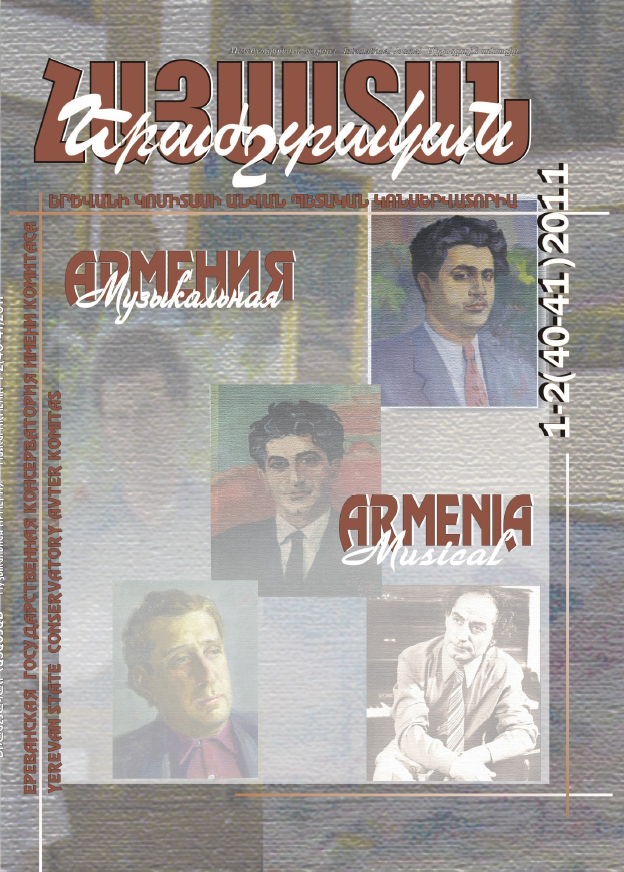ՀԱՍՄԻԿ ԼԵՅԼՈՅԱՆ հայկական քանոնը միջազգային բեմերում
Abstract
The article “Hasmik Leyloyan: Armenian Qanon on international stages”of musicologist, editor in chief of newspaper “Erazhisht” (from 2008 to 2011) of Yerevan State Conservatory after Komitas Hasmik S. Hambaryan is an interview portrait of qanonist, Meritorius Artist of RA, Lauriate of international competition, proffesor of Yerevan State Conservatory after Komitas Hasmik A. Leyloyan. The name of the deserved artist of RA, professor of Yerevan State Conservatory after Komitas, laureate of international competitions, Qanon player Hasmik Leyloyan is already known to a wide range of audience. She has deserved the love and respect of admirers of Armenian folk music. The famous Qanon player Hasmik Leyloyan is considered the innovator of classical school of Armenian Qanon, not only for her new performing styles, but also for bringing in two-part concerts (in 1974 her first recital), by brilliantly performing her exclusive improvisations and instrumentations: Sarasate - "Gypsy Tunes", "Khabanera", Chopin - "Waltz N7", Liszt - "Hungarian Rhapsody" N2, Albeniz - "Prelude", Paganini - "24 Capris", Saint-Saens - "The Introduction and Rondo Capriccioso" and many others, which in a new way represent wide abilities of Qanon. The well-experienced artist perfectly possesses both the virtuoso and expressive techniques of the instrument and demonstrates unique performance of both national and classical difficult compositions. This is the reason she is considered the "Queen" of Qanon. She was born in Yerevan. In 1981 she graduated from Yerevan State Conservatory, being the student of composer professor Khachatur Avetisyan. Hasmik Leyloyan is the first graduate of the Chair of National Instruments. Having graduated from the Conservatory, she immediately began working as in instructor in the Chair of National Instruments of the same institution. Since 1970ies, Hasmik Leyloyan has undertaken a wide range of concert and teaching activities. For many years she has been the soloist of the Armenian State Symphony, and then of the Symphony and Pop Orchestra of the Armenian Radio. She has performed with different symphony orchestras: orchestras of Montreal, Toronto, Marcel, Sydney, Beirut, New York, and National Instruments Orchestra after Osipov of Moscow. She is co-working with various musicians: Ara Gevorgyan, Karen Durgaryan, Yervand Yerznkyan, Daniel Decker, Pedro Eustache, Hiba Al Qawas, Rony Barrak, Konstantin Moskovich and many others. Hasmik Leyloyan has given concerts in more than 50 countries of the world. She has many radio and TV recordings, included in the state funds as well as a number of compact lazer disks ("Zartonk", "Come Back Darling", "Fly My Heart", "Around The World", “Collag” "Nostalgia") and video recordings ("Golden Strings", "Come Back"). Hasmik Leyloyan is an author of many books and collections for Qanon, which are already included in the repertoires of many Qanon players: "Selected Works", "Treatments for Qanon", "Concert Compositions for Qanon", "Gamma-Arpeggio Exercises and Etudes" manual for performing technique development for Qanon , Armenian School of Qanon" two-volume textbook, where are also included the first steps for teaching Qanon. Hasmik Leyloyan is actively continuing her different activities, is instructing in the Conservatory and is conducting master classes for teachers and pupils of different institutions of the country, by helping them to understand the performing secrets of the ancient instrument. Being a skilled pedagogue, she has educated many pupils not only from different regions of RA, but also from other countries around the world. Since 80ies Hasmik Leyloyan is trying to create a new Qanon, which tunes will be chromatic. The handles (by means of which semitones are received) that affect the freely mastering of Qanon's technique will be removed. This idea is already coming to life and the first instruments are already being made by great master of Qanon Apres Vanoyan and will gradually enter musical sphere. Invaluable is her work done towards the development and teaching of the instrument, as well as towards spreading and maintaining it.



